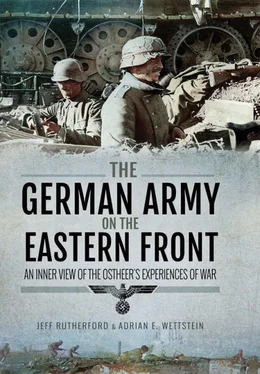New weapons therefore shaped the organization of the German army in the East, which seems to be a not overly surprising insight. What is underestimated by historians, however, is the other side of the coin; namely that slowly adapting organizational structures prevented the timely and effective use of new weapons.
As previously shown, the German army encountered many new types of terrain and fighting, which also demanded a learning process. Urban warfare, a now common issue in military practice, was relatively new during the Second World War. [20]There were a few battles on a smaller scale in 1939 and 1940, but the German army was confronted with urban warfare on a large scale from summer 1941 on. The most famous of these battles was the one for Stalingrad. By that time, the German army had learned many lessons about this type of combat. Units sent to Stalingrad summarized these lessons in information sheets for their commanders, such as the following issued by the 305th Infantry division: [21]
Combat in densely built-up areas is marked by the following characteristics:
Complexity, fragmentation of every combat situation into individual actions, thereby aggravating leadership even in lower-level units; a reduction of our own weapons’ effectiveness; difficulty in recognizing the enemy’s main battle line [and] strongpoints, danger of ambush; limited effect of our own local successes.
Command : Careful preparation, clear briefing on the local situation with maps (sketches), unambiguous designation of the – mostly limited – objectives of the attack and systematic coordination of the separate combat actions are the preconditions for success.
The sure recognition of the moment, in which one can deviate from the systematic advance after local successes and go over to deep breakthrough, is the art of command.
To guarantee permanent insight in the course of the combat actions and the crucial personal influence, all leaders have to be as close to the troops as their command tasks allow.
Combat in the formal deployment structure will be the exception, the formation of battle and combat groups of all branches will be the norm.
Most often, success depends on low-level commanders acting on their own initiative. It is therefore important to give them a detailed picture of the contexts of the planned combat actions beyond their own limited mission; this is the precondition not only for individual initiative, but also for appropriate conduct in the sense of the entire combat action.
Combat conduct : Combat will generally be fought from short and even shorter distances; it naturally disintegrates into a series of successive assault detachment operations . The number of the required assault detachments [and] their composition is the concern of the lower command; it arranges the timed sequence on the basis of exhaustive reconnaissance and planning.
Precise reconnaissance and detailed discussion of the combat plan is a prerequisite of success.
The combat mission and nature of the attack objective determine the composition and combat form of the battle groups.
The use of tanks, assault guns, heavy infantry weapons and individual guns in the frontline, as well as engineer assault detachments with flame throwers, is the rule. Guns are to be moved forward by the crew (muzzle forward, shell in the barrel).
When using assault guns, one has to keep in mind their weakness against fire from above.
Principle: Through their fire, the heavy weapons cover the assault detachments reaching the attack objective; in the conquered target areas, the assault detachments enable the forward move of the heavy weapons and their positioning for covering fire for the next push of the infantry (engineer) assault detachments.
Due to the difficulty in recognizing the enemy’s resistance line (strongpoints, concealed weapons which hold their fire until the enemy has reached certain points), the build-up of a surveillance coverage fire is most important, in addition to covering fire against identified objectives. Shooting ‘on suspicion’ will be used frequently. Cellar rooms and rooms on the ground floor are generally to be neutralized by hand grenades. The feeding of reserves, who have a previously determined combat mission, are to shield the flanks of the territory won.
Special cleansing units are to be brought forward behind the battle groups. It is their task to destroy overlooked strongpoints and to put down any revived resistance behind the battlefront. Brutal hardness is necessary.
Riflemen on the roof are irritating, but not decisively dangerous; their zone of effectiveness is limited.
The conquered area is to be cleansed thoroughly by reserves ordered for this purpose after the end of every local combat action as well as after reaching daily objectives. Surprises are always to be expected. An opponent familiar with the location uses canals, subterranean tunnels, [and] roofs to emerge unexpectedly in the rear of our own troops.
The leaflet highlights German tactical practices, such as the importance of a combined arms team and decentralized leadership, both of which were very effective under urban conditions. It also emphasizes the assault group as the most important element of fighting in the city. While close combat was recognized as the rule, even under urban conditions German units tried to support their advancing troops with as much firepower as possible. The difference with other types of combat lay simply in increasing direct firepower, including providing assault troops with individual artillery guns for point-blank fire support. On the other side, one should be clear that German troops had no qualms about inflicting collateral damage on civilians present in the combat area. This was simply not an issue in the tactical guidelines.
An even larger theme for the German army in the east was the return of positional warfare. The German army went to war extremely offensive-minded and, as a consequence of the First World War, with a strong will to fight the war as a war of movement. When the Soviet counter-offensive in winter 1941/42 petered out, both sides lacked the power to resume the offensive along the whole length of the front. In the following years, a war of movement was an exception, limited in time and space, from the prevailing positional warfare. In summer 1942, the Germans attacked only on the southern wing of the Eastern front, with the sectors of Army Group Centre and North remaining static for the rest of the year. Soviet offensives directed at these sectors failed to dislodge German positions, with the exception of a few kilometres here and there. The German offensive bogged down in most sectors in September, gaining little space in October and November. The next phase of the war of movement was a Soviet one, reconquering most of the territory lost in the summer 1942, but it was also temporary and limited to the southern wing. The Soviet offensives in 1943/44 happened in phases and on individual sectors. While being significantly larger than before, there were still areas in which positional warfare predominated with consequently minor changes in the front line.
German troops in the east had to relearn positional warfare and adapt their procedures to evolving Soviet tactics and operations against defensive positions and fortifications. The remarks of the commanding general of the VIth Army Corps, General der Infanterie Hans Jordan, defending the western shoulder of the Rzhev bulge, highlight a few aspects of that learning process. [22]This time, learning did not happen by compiling and analyzing lower-level reports, but rather by a higher commander visiting his subordinated units at the front, a practice described in chapter 2. The close monitoring of the front through frequent visits by German commanders sped up the learning process.
Читать дальше






![John Stieber - Against the Odds - Survival on the Russian Front 1944-1945 [2nd Edition]](/books/405234/john-stieber-against-the-odds-survival-on-the-russian-front-1944-1945-2nd-edition-thumb.webp)





